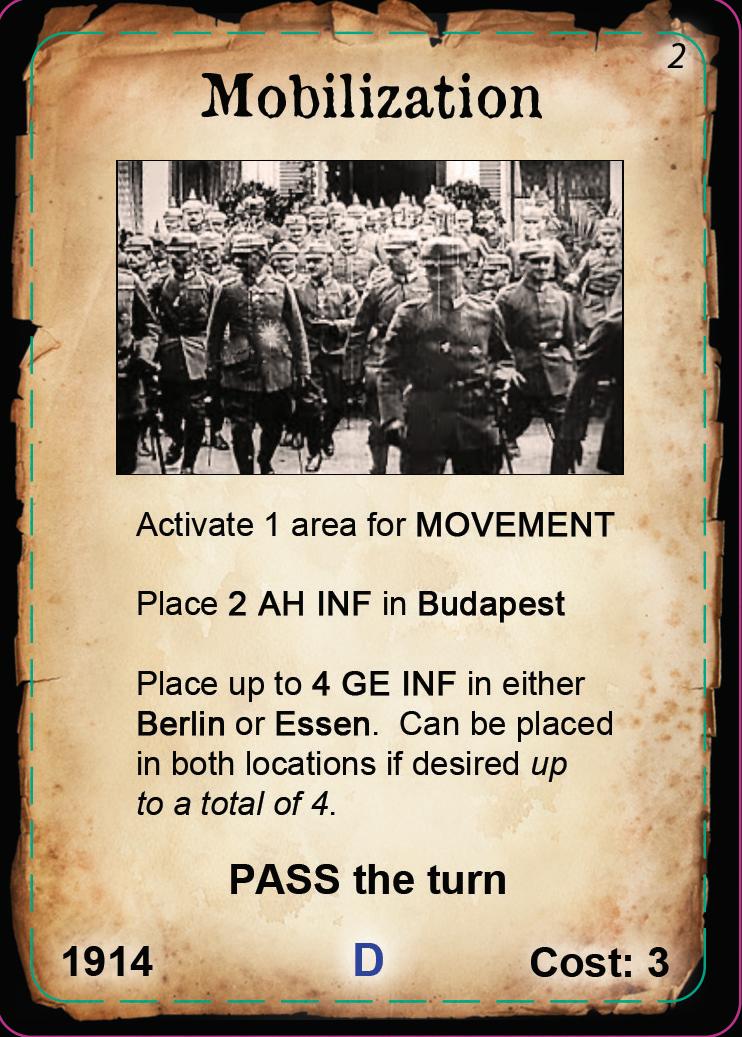
3 minute read
3. Game Components
The Game consists of the following:
One Rulebook One Solitaire Play Aid card One 22” x 34” map One deck of 51 cards Two six-sided dice One Box with lid
There are three types of cards. These are Year, Central Powers cards, and Allied Powers cards.
Year Card
Central Powers Allied Powers Card Back Card Back
Card Front
Two counter sheets with 216 counters total
The counters depict varying amounts of units. There are four types of units and several types of markers: Infantry units These represent all types of ground combat troops. They range in strength from one to five points.
Example of five GE INF points, not entrenched. Artillery units These represent stockpiles of artillery ammunition and are expended upon use. Heavy Artillery units These represent stockpiles of large-caliber artillery ammunition and are expended upon use.
Example of Artillery markers. Both players use the same markers.
BEF unit This represents the British Expeditionary Force, highly trained professional soldiers (as opposed to the conscripted mass armies of later years in the war), and has special game abilities. Any points from it that are lost cannot be replaced.
Example of the BEF unit reduced to two strength Entrenchment This is not a marker but is a status shown by flipping an infantry unit over to the “entrenched” side. Units start this way by scenario setup, or are allowed to do so by card play and serve to reduce any damage in the Main Combat Phase by one. For example, a single entrenched INF unit would require two or more incoming damage points to eliminate it. A result of one damage point would simply be ignored.
Example of four GE INF points flipped to the entrenched side.
Control marker These markers are placed to indicate control of an area. Both sides start with control of all areas inside of the national boundaries of the nations that are part of their alliance. The markers should be placed on areas that have switched control to the opposing powers. If an area is subsequently “liberated”, simply remove the other side’s control marker.
Example of a Control marker.
Movement/Attack activation marker These are included to assist players in keeping track of which areas have been activated for movement or designated for an attack. Their use is optional.
Example of an Attack Activation marker. Destroyed Fort marker These markers indicate if a fort has been destroyed.
Example of an Destroyed Fort marker. Resources marker Each nationality has a resources marker for use on the Resource track, which indicates the number of Resource Points it currently has. The flip side of the marker indicates that the yearly attack option has been used. Resource Points have multiple uses.
Example of the Austro-Hungarian Resource marker. Next Year Build Point Modifier markers These markers (ranging from -1 to -3) indicate the effects of card play on next year’s build point totals.
Below are counter examples:
I FR INF unit 2 US INF unit
I GE INF unit 2 BR INF (BEF) unit
Units may split up and combine as long as they are the same type and nationality. For example, four INF units can be represented on the map by a 3 and a 1, or a 2 and a 2, etc. This has no impact on game play. Think of them as money...there’s no difference between a nickel and five pennies. The various sizes are included so that players may reduce strengths of larger units due to combat losses, or split them up during movement. What matters is that the correct numbers are left on the map after movement and combat.
Entrenched side Strength Unit legend:
National colors
Card legend
Solitaire Bot Rating
Year
Card ID Number (1-24 per player side)




